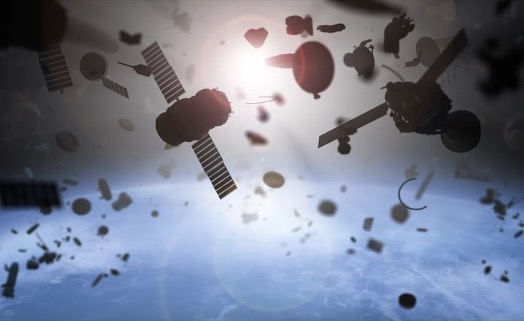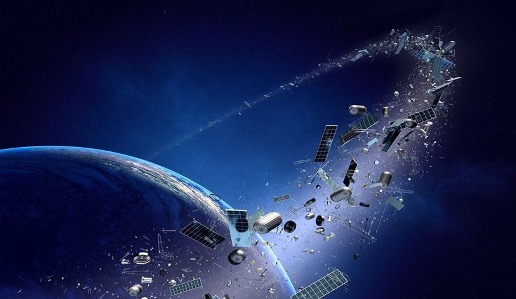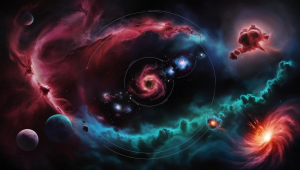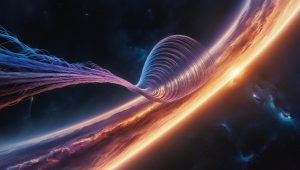
WORMHOLES:COSMIC SHORTCUTS
What if you could rocket from Earth, not to the Moon or Mars, but down a wormhole that loops all the way across the vast Milky Way, slashing travel time
Space debris, also known as space junk, refers to the defunct artificial objects orbiting Earth. These objects include decommissioned satellites, spent rocket stages, and fragments from collisions and explosions. As humanity’s activities in space have increased, so too has the accumulation of space debris, posing significant risks to both current and future space missions. Addressing this problem requires innovative solutions and international cooperation. Here’s an in-depth look at the space debris issue and the strategies being developed to mitigate it.
Comprehending the Space Debris Problem
 Because of the launch of the initial fabricated satellite, Sputnik 1, in 1957 the variety of things in Earth’s orbit has actually expanded greatly. Since 2024, there are 10s of hundreds of tracked items bigger than 10 centimeters as well as numerous smaller sized items that are challenging to track. Also small fragments as a result of their high velocities, can create disastrous damages to satellites, spacecraft as well as the International Space Station (ISS).
Because of the launch of the initial fabricated satellite, Sputnik 1, in 1957 the variety of things in Earth’s orbit has actually expanded greatly. Since 2024, there are 10s of hundreds of tracked items bigger than 10 centimeters as well as numerous smaller sized items that are challenging to track. Also small fragments as a result of their high velocities, can create disastrous damages to satellites, spacecraft as well as the International Space Station (ISS).
The Kessler Syndrome suggested by NASA researcher Donald J. Kessler in 1978, defined a situation where the thickness of items in reduced Earth orbit (LEO) is sufficiently high that crashes in between items might create a waterfall, developing even more debris together with enhancing the possibility of more crashes. This self-dependent domino effect can provide room tasks in particular orbits incredibly risky.
Impacts of Space Debris
Functional Satellites: Space debris presents a straight danger to the around 3,000 functional satellites in orbit. Accidents can result in the loss of beneficial properties, disturbances in interaction, navigating, and also Earth monitoring solutions.
Space Exploration: Human area goals consisting of those to the ISS face considerable threats from area debris. Also little bits can pass through the safety shielding of spacecraft, endangering the lives of astronauts.
Financial Costs: The monetary ramifications of room debris are substantial. The loss of satellites, the expense of accident evasion maneuvers, along with insurance policy costs all add to the financial worry.
Approaches to Tackle Space Debris
Minimization Measures: Layout for Demise: Satellites as well as rocket phases can be developed to wear down totally upon re-entry right into the Earth’s environment, minimizing the quantity of debris left in orbit.
End-of-Life Procedures: Satellites must be furnished with devices to relocate them to a burial ground orbit or move them at the end of their functional life.
Energetic Debris Removal (ADR): Several modern technologies are being established to proactively get rid of debris from orbit. These consist of:
Automatic Arms and also Nets: Spacecraft furnished with automated arms or the internet can catch along and move big items of debris.
Harpoons and also Tethers: Harpoons can be made use of to catch debris as well as bring it to reduced orbits where climatic drag will at some point create it to come back and also wear down.
Lasers: Ground-based or space-based lasers can be made use of to transform the trajectory of smaller sized debris items, triggering them to come back the ambience quicker.
Room Traffic Management (STM): Improved monitoring as well as control of room tasks are critical to preventing accidents. Boosted sensing units in addition to data-sharing systems can assist keep an eye on the placement combined with trajectory of items in orbit enabling prompt mishap evasion maneuvers.
International Collaboration: Addressing the room debris trouble calls for worldwide participation. Initiatives such as the United Nations’ Committee on the Peaceful Uses of Outer Space (COPUOS) as well as the Inter-Agency Space Debris Coordination Committee (IADC) advertise worldwide standards together with ideal methods for room debris reduction.
Regulative Frameworks: National plus global regulatory bodies are required to enforce rigid standards for satellite drivers. This consists of necessary end-of-life disposal strategies as well as adherence to debris reduction criteria.
Future Outlook
The room debris trouble is anticipated to get worse as area tasks remain to expand. The expanding business room sector, with mega-constellations of tiny satellites, worsens the danger of crashes as well as debris generation. Nevertheless, with collective initiatives from federal governments, global companies, combined with the economic sector, reliable services can be executed.
Advancement will certainly play an essential function in resolving area debris. Proceeded r & d of ADR modern technologies along with developments in STM and also enhanced satellite layout will certainly be essential. Better promoting a society of sustainability in room tasks, just like the ecological motion in the world, is necessary to guarantee the lasting expediency of area expedition together with utilization.
The room debris trouble is a pushing concern that intimidates the future of area expedition coupled with satellite procedures. By taking on detailed reduction procedures creating energetic debris elimination innovations, boosting room website traffic administration plus cultivating worldwide partnership we can minimize the threats as well as prepare the method for an environmentally friendly future in the area. The obstacle is substantial yet with technology together with teamwork humankind can remain to discover and also gain from the last frontier securely as well as properly.

What if you could rocket from Earth, not to the Moon or Mars, but down a wormhole that loops all the way across the vast Milky Way, slashing travel time

If you go outdoors on a clear evening and also search for it, you might have the ability to see Jupiter beaming brilliantly amongst the celebrities. At the exact same

Stars, the dazzling points of light that fill up the evening skies are the foundation of galaxies plus the cradles of life itself. From their birth in large clouds of

In the mission to recognize deep space mankind has actually developed progressively effective devices to observe deep space. Completion of this venture is the Extremely Large Telescope (ELT) which is

The search for exoplanets– planets that orbit stars outside our planetary system– has actually quickly developed into one of the most interesting and dynamic fields of astronomy

Gravitational waves stand out as a remarkable finding in today’s universe explorations. Over a century ago Albert Einstein predicted that these waves exist in the fabric of space-time. By generating
Write to
Jasmine Gogoi at csr@scientifictemperament.com
Let’s develop our society with a scientific heart. Join us to build the scientifically nurtured future →